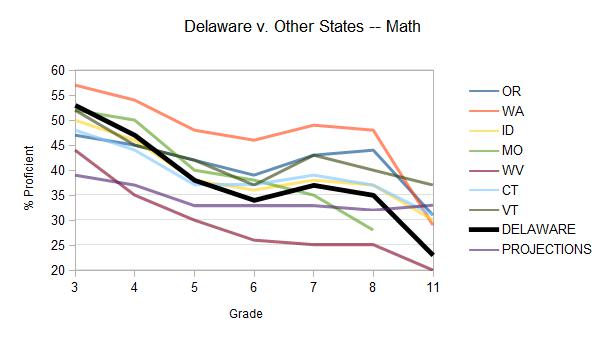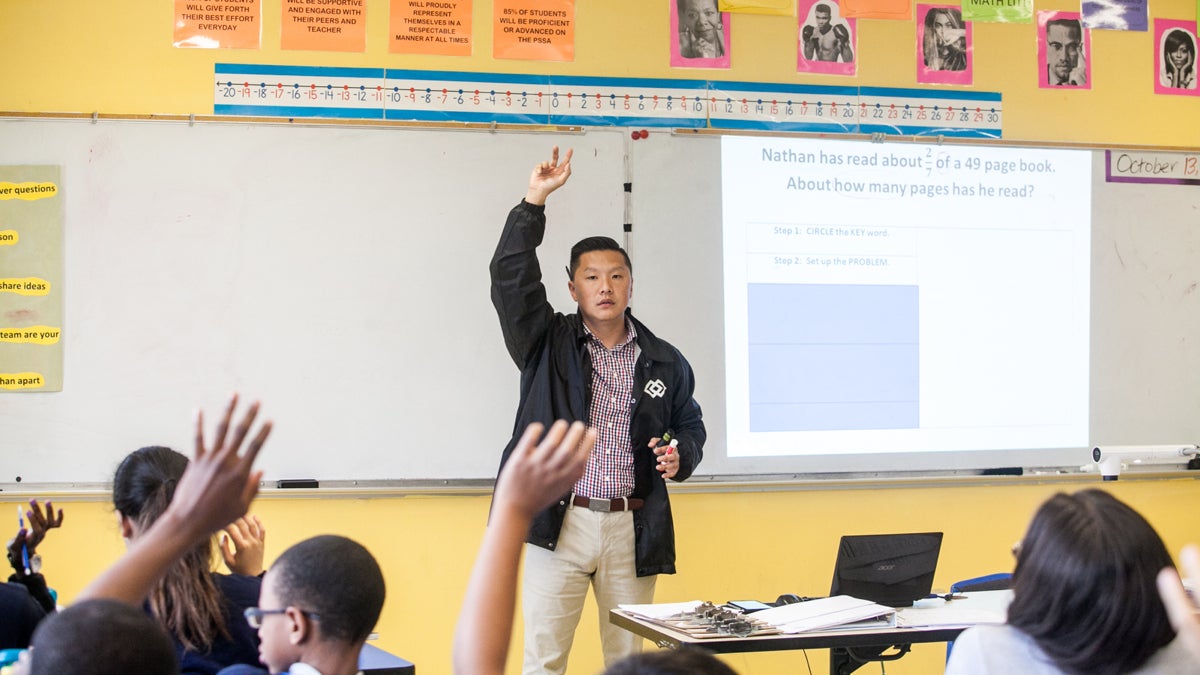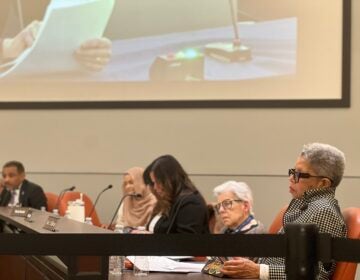Has Mastery lost its mojo? (The quest to fix Philly’s biggest charter network)

Seventh grade students at Mastery Charter School's Thomas Campus hold up answers to pre-algebra word problems. (Brad Larrison for NewsWorks)
Test scores have begun to slip at Philly’s largest and most successful charter network. Now the race is on to figure out what went wrong.
UPDATE: Mastery Schools CEO Scott Gordon responded to NewsWorks. See his comments at the end of the story below.
—
On a recent Thursday, math teacher Beth Wendell is teaching her third graders at Mastery-Clymer Elementary School in North Philadelphia how to add two-digit numbers.
She’s written a problem on an easel wedged into the corner of the room:
11
24
+15
————
You know how to solve this problem right? Add the right column of numbers. Carry the one. Add the second column of numbers. Voila.
But Wendell doesn’t go that route — at least not at first. Instead she directs her students to reach into large plastic bags filled with little counting Lego-style items called base-ten blocks. Their purpose is to teach students the basic concept behind addition so they can feel and see what these numbers mean. The number 11 is represented, for instance, by one little block and one larger block made of ten little blocks glued together.
When students collect ten of the little blocks they can exchange them from one of the larger blocks. After some coaching and counting the students stumble toward the right answer.
Then Wendell swings over to the easel and does the same problem using the familiar “paper and pencil” method. Finally, she offers her students a choice.
“When we do our next two together we’re going to use base-ten blocks and paper-pencil to see which one you like better,” Wendell says. “You will get to choose.”
 Third grade teacher Beth Wendell guides students through a math lesson at Mastery Clymer Charter School in North Philadelphia. (Avi Wolfman-Arent/WHYY)
Third grade teacher Beth Wendell guides students through a math lesson at Mastery Clymer Charter School in North Philadelphia. (Avi Wolfman-Arent/WHYY)
The quest to fix Mastery Charter Schools, the biggest, most successful charter network in Philadelphia, hinges on a choice between old and new — between what’s worked in the past and what students need for the future. How Mastery navigates that choice could well determine its fate as a charter operator, as well as the fate of charter-driven education reform in Philadelphia.
That’s because after years of excellent, some might even say stunning, test scores, Mastery has hit a wall. The network is changing the way it teaches math in hopes of scaling that wall, and surmounting perhaps the most significant challenge it has faced in 15 years at the forefront of Philadelphia education.
Masters of the turnaround
There are charter schools in Philadelphia. And then there’s the Mastery Charter School network. Mastery is massive. It educates more than 10,000 students across the city. And unlike most charters, Mastery doesn’t start new schools. Rather it takes over struggling ones from the Philadelphia School District and tries to revive them.
Many charter operators have shied from the school turnaround model. That’s because it’s difficult. Taking over schools creates tension and invites burdens. Plus, it requires the charter educate any child in the school’s catchment area who wishes to attend, and therefore disallows the kind of enrollment practices that allow some traditional charters to avoid teaching the most disadvantaged students.
But Mastery has embraced school turnaround with gusto, earning a national reputation for its willingness to take on some of the toughest schools in Philadelphia. The work has drawn accolades from former U.S. Education Secretary Arne Duncan, Oprah Winfrey, and even Barack Obama.
But over the last two years the network’s results have started to slip, so much so that it has alarmed the organization’s upper management. Now Mastery’s leaders are racing to figure out what went wrong.
“There is a promise between Mastery as an organization and the parents and families we serve that we’re going to prepare your children and help your child grow to be the person they want to be,” said Mastery CEO, Scott Gordon. “And right now we feel like we’re not fulfilling that in the way we believe we can. So we’re going to fix it.”
The birth of “Mastery 3.0”
Soon after its founding 15 years ago, Mastery adopted what education wonks call a “no excuses” model. Popular among urban charter networks, “no excuses” emphasizes strict discipline to create orderly schools. In the classroom teachers drill students over and over again on familiar formulas–and bombard them with extra support if it doesn’t appear they’re making progress.
“We were very focused on skills and procedures,” said Gordon. “And there was a real focus on practice. Practice. Practice. Practice.”
That approach may sound soulless, but it worked. When Mastery took over Clymer in 2011, for instance, just 32 percent of students were testing on grade level in mathematics. By the end of the 2014 school year, that number had climbed to 48 percent. Perhaps more impressive, the proportion of students considered advanced went from 7 percent to 22 percent in just three years.
Similar stories played out across the Mastery network. Within the first few years of a Mastery takeover scores would spike. Then, curiously, they would plateau. Schools routinely approached — and sometimes even exceeded — the state average in math or reading scores. They did not, however, continue climbing toward the lofty marks set by high-performing suburban schools.
There was another downside to Mastery’s “no excuses” approach. Alum told school leaders that the focus on basic skills, intense practice, and smothering support helped them soldier through high school and even into college. But the students said they weren’t becoming self-sufficient, as people or as learners. Too often in college or the real world they floundered.
“I’m proud of what we did the previous 12 years. It was the foundation,” said Gordon. “I was not satisfied. Our parents weren’t satisfied. Our students we’re satisfied with where they were at and felt like we could do more and needed to do more.”
Two years ago Mastery ditched “no excuses” for a new approach it dubbed “Mastery 3.0.” Strict disciplinary policies gave way to restorative justice practices that focus on making amends. On the teaching side of the ledger, Mastery pivoted toward conceptual learning. It wasn’t enough anymore to teach students a formula. They needed to understand the underlying mathematics.
In essence, Mastery wanted to emulate the type of learning environment a kid might find at a great private or suburban school.
All this happened as Pennsylvania was introducing new math and reading exams that would be aligned to the Common Core and were designed to better test students’ conceptual understanding of the material. Mastery jumped with both feet into the Common Core revolution.
“We want our kids and believe that our kids can be competitive with kids anywhere,” said Gordon. “We believe that our kids need not just to be able to pass the test, but need to really understand mathematics so they can apply it.”
A big change…and then a big drop
After year one of this change, Mastery’s test scores plummeted. The same was true at schools across the state — the new batch of tests was expected to be more difficult than their predecessors. Mastery’s braintrust noticed, however, that their math scores seemed to drop further than most.
The network’s leaders didn’t panic. They’d already accounted for some growing pains during this organization-wide pivot. Plus, there were all sorts of positive indicators in terms of student retainment, discipline trends, and teacher satisfaction.
Then the second year of test scores came out this summer. Little changed. Mastery schools were still, on the whole, performing worse than they had prior to the shift away from “no excuses.” The pattern was especially obvious in mathematics.
Up and down the organization people were devastated.
“When you see the blood, sweat and tears from every direction: from parents, from teachers, from students. People giving their all. And then when you get those results it’s…crushing,” said Tiffany Holmes, principal at Clymer.
For his part, Gordon said the day he received the 2016 test scores was one the worst he’s had in 15 years as Mastery CEO.
Mastery calibrates each school’s performance on state tests relative to the state average for the grades it serves. If a school scores 100 percent that means it’s exactly at the state average. During its last year as a district school, Clymer’s proficiency scores in math were 41 percent of the state average. That number rose to 71 percent by 2014.
Last year, Clymer scored at just 23 percent of the state average. In other words, students at Clymer now fare considerably worse in math, at least compared to the state average, than they did before Mastery took over.
Test scores at Mastery-ClymerCreate line charts
Mastery-Thomas in South Philadelphia was one of the network’s first turnaround schools in 2005. Its students routinely scored at or above the state average until the simultaneous implementation of a new school strategy and a new school test.
Test scores at Mastery-ThomasCreate line charts
When Peter Ruggiero, a seventh-grade math teacher at Mastery-Thomas, saw his students’ scores over the summer he was crushed.
“It made me feel like a failure as a teacher,” he said.
He wasn’t alone. Across the network test scores stayed relatively flat from 2015 to 2016.
Mastery 2.5?
And so two years after leaping into Mastery 3.0, the network decided to make another shift. Leaders decided to step back from the all-conceptual approach and give teachers more freedom to use the direct-instruction methods they’d relied on during the “no excuses” era.
Ruggiero is on the front lines of this latest change.
Last year, Ruggiero’s class was arranged in small clusters of desks where students often worked independently and dictated the pace. The instruction focused almost exclusively on conceptual learning, leaving little time for students to work on problems.
“It’s like when a coach teaches you how to shoot a basketball. They teach you the technique and why you shoot it this way. But then you gotta remember they practice to get better at it,” Ruggiero said. “The curriculum we used last year, it did a great job explaining to students how and why math works. But there was very little practice.”
This year, Ruggiero is back at the front of the classroom and all desks face forward. There are still traces of conceptual learning, but it’s mixed with equal doses of what Ruggiero calls “drill and kill.” In other words, practice is back.
 Math teacher Peter Ruggiero goes over pre-algebra with his seventh-grade class at Mastery Charter’s Thomas Campus in South Philly. (Brad Larrison for NewsWorks)
Math teacher Peter Ruggiero goes over pre-algebra with his seventh-grade class at Mastery Charter’s Thomas Campus in South Philly. (Brad Larrison for NewsWorks)
If concepts aren’t sticking with students, Ruggiero now has the freedom to use mnemonic devices or steer them toward formulas so they can at least get the right answer.
One of Ruggiero’s favorite acronyms is “GFTA”, which stands for “Gotta Find The Answer.” The letters also correspond to the steps of a decoding technique students can use to breakdown word problems often found on standardized exams. Ruggiero used GFTA religiously for years, but had to ditch it during the early days of “Mastery 3.0”
“I brought it back out of the closet,” Ruggiero said.
“Just teaching them the little tricks like that — which I got to do very little with the curriculum we did last year — I think helps students a lot.”
All across the Mastery network, math teachers are dusting off old, reliable acronyms and answer-getting techniques. In Tiffany Joynes’ sixth-grade math class at Clymer students are learning the steps of long-division with a memorization technique called “Father, Mother, Sister, Brother.” Joynes was overjoyed when she heard Mastery would be walking back its full-throttle commitment to conceptual learning.
“We’re meeting in the middle,” she said. “We’re finally meeting in the middle. I have a lot more flexibility with these students.”
Mastery has essentially shifted to a “what works” model. If students can grasp the conceptual knowledge, great. If they can’t or if they come to Mastery so far behind they need a crash course, teachers are free to lean on the “skills and procedures” approach.
“We had swung one way. And then we were swinging another way. And now we were trying to find that balance in instruction,” said Holmes, the principal at Clymer. “We were relieved. We were like, ‘Yes! They heard us.’”
Cute tricks, real math, and finding the middle ground
Could that shift back to the middle, however, prove harmful for Mastery’s students? After all, Mastery ditched skills and procedures because it felt that style of teaching stunted students’ long-term growth. By allowing students to choose between a procedural and conceptual understanding of mathematics might Mastery be setting its kids up for failure?
Schools and districts across the country are asking those very questions as they wade warily into the Common Core era. Those who wrote the standards designed them as a middle-ground between old guard mathematicians who favored procedural knowledge and reformers who favored a conceptual approach. In that regard, Mastery’s search for a middle path may be better aligned to the Common Core than its initial attempt to embrace it.
The Common Core’s architects, however, also wanted to change the way American teachers approach mathematics. They didn’t want teachers to simply pick whatever style — procedural or conceptual — best allows a student to find the solution. That reliance on answer-getting had made it too easy for instructors to avoid teaching what lies beneath, the intricate network of ideas that make mathematics a coherent system of knowledge.
“Students do have to learn how to get the correct answer. That has not changed,” said Phil Daro, who helped write the Common Core’s math standards. “What’s changed is they’re supposed to use mathematics to get the correct answer and that getting the correct answer by using some mnemonic device or cute trick is not learning mathematics.”
The future of charter reform
When it first pivoted, Mastery was aiming for something higher than cute tricks. The school’s leader didn’t want their network to be a factory for high test scores, especially if it was at the expense of deeper learning.
But in some ways, for schools like Mastery, deeper learning is a luxury. Mastery runs charter schools. If charter schools don’t produce results they can be shut down. Because of its track record, Mastery isn’t facing an existential crisis yet. But it will be eventually if things don’t turn around.
“It’s probably still a couple years away,” said Mark Gleason, head of the the Philadelphia School Partnership (PSP), one of the region’s largest private education funders. “It’s not ten years away. That’s for sure.”
PSP has been a stalwart backer of Mastery, pledging $13.1 million into Mastery schools over the past five years. Gleason says he still believes in the organization and is heartened by its decision to examine itself, take in criticism, and adjust. Few, if any, question Mastery’s dogged determination to fix its mathematics woes. But determination alone can’t save Mastery in the long run.
“Clearly we’re already at a point where we all need to be paying closer attention,” said Gleason. “We’re not going to wait a year to find out how are things going at Mastery. We’re going to see how are things going in November and January and March so that when state results come out a year from now hopefully there aren’t surprises”
Mastery has become a symbol for the entire school turnaround movement — for the idea that privately run charter schools can sweep into public schools and make them substantially better. It’s a concept some education reformers love and some public schools advocates love to hate. To some extent, at least here in Philadelphia, its fate is tied up in Mastery’s fate.
The Renaissance Charter Initiative — the School District of Philadelphia’s main organ for converting struggling district schools into charters — consists of 21 schools. Mastery runs nine of them.
Since its inception in 2010, the Renaissance initiative has sat in the political crosshairs. That’s partly due to the disruptive nature of converting schools, partly due to the howls of those who oppose the privatization of public assets on principle, and partly due to the initiative’s own failings.
In the last year alone, a Renaissance charter unexpectedly pulled out of its contract at one school while the district’s charter office recommended four others be closed due to poor academic performance and/or organizational failings. The district recently announced it is conducting a comprehensive review of the Renaissance initiative and will not add any more schools to the mix this year. (The school district denied a request to speak with the head of its charter office about that review and how Mastery’s struggles might influence it.)
It’s no doubt a fragile time for the turnaround concept in Philadelphia. If Mastery continues to falter, the cries of those critics who oppose school turnaround will likely grow louder.
“Clearly if Mastery continues to struggle that’s going to create certain repercussions for turnaround as a strategy writ large across Philadelphia,” said Gleason.
CEO Scott Gordon believes his schools are on the verge of finding that perfect balance between old school and new–between paper/pencil and base-ten blocks. He still believes his schools can produce good test scores and well-rounded students.
For years Mastery has built its name fixing broken schools. Now the race is on to fix itself.
—
Statement from Scott Gordon, CEO, Mastery Schools:
Mastery invited Mr. Wolfman-Arent to visit Mastery classrooms because we wanted to share our recent lessons learned with the larger education community. We believe the challenge of both providing an engaging, holistic education and preparing students for today’s higher academic standards (particularly common core math), is a challenge for all schools – particularly those serving low-income communities.
The reader should have some context: struggling schools are identified as potential Renaissance Schools because they consistently score in the bottom 10 percent or 20 percent of all Philadelphia schools prior to a turnaround. In 2016, 100 percent of Mastery Renaissance schools open one year or more are now rated in the top 50 percent of all 301 public and public charter schools in Philadelphia on the state’s recently released School Performance Profile (SPP) that rates schools statewide based on student achievement.
For the last six years of the Renaissance program, we are proud to have demonstrated that all schools can become safe, joyful places where kids can learn and achieve. We are actively committed to taking our schools to the next level so our students can be competitive with students anywhere in this country and be empowered to pursue their dreams.
WHYY is your source for fact-based, in-depth journalism and information. As a nonprofit organization, we rely on financial support from readers like you. Please give today.





